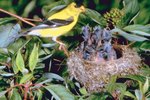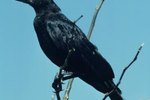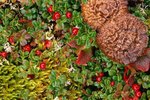
More than a few species of quail inhabit North America and all share several characteristics and preferences. Although they're known as game birds and some are raised commercially for food, some species also make ideal pets for outdoor aviaries. Examples of species include bobwhites, Montezuma quail, California quail and Gambel's quail.
Size
Known as excellent game birds, quails most generally are characterized by plump, round bodies, somewhat similar to chickens. They're rather short and, in most cases, have an average length of around 8 to 10 inches. Weight varies greatly between species, and also between wild and captive-bred birds. A mean mass of 6 to 8 ounces is most common in wild species.
Plumage
Some of North America's native quail are treasured for their interesting plumage. The California and Gambel's quails, for instance, have a grayish-blue plumage overall with a black and white face. The California quail has a brown and white belly with a scaled appearance and a teardrop-shaped, black plume on its head; Gambel's quail has a blue belly marked with black and cream bands. While the mountain quail resembles the California and Gambel's, it has deeper blue along with rust-colored areas on its chin, neck and belly. Bobwhites and Montezuma quail, on the other hand, lack the plume on the forehead and have brown and white bodies marked by black and white faces.
Diet
Quails are primarily herbivores, although a very small portion of their diet consists of various arthropods. Seeds and leaves are the majority of their diet, although fruit, berries, roots and tubers are also on the menu. Their diets often change throughout the year when different types of foods become more plentiful. The Montezuma quail, for example, prefers to dig up bulbs, roots and tubers from plants such as sorrel and sedges. Several species don't need an external source of water, although they will take advantage of fresh water if they happen to be nearby.
Habitat
When in a forest habitat, bobwhites prefer to live in fresh, young vegetation that is the result of disturbance such as fire or logging; they also inhabit rangelands. Gambel's quail prefers desert habitats that have plenty of cover from brush and thorny plants. Montezuma quails, on the other hand, prefer vegetative communities such as oak-pine woodlands. The California quail is somewhat similar to the bobwhite in habitat preferences: they'll inhabit open woodlands or foothills, and they also live closely with humans in suburban areas.
References
- Quail Forever: Different Quail Species
- University of Michigan Animal Diversity Web: Callipepla Californica
- University of Michigan Animal Diversity Web: Callipepla Gambelii
- University of Michigan Animal Diversity Web: Cyrtonyx Montezumae
- University of Michigan Animal Diversity Web: Colinus Virginianus
Photo Credits
-
Jupiterimages/Photos.com/Getty Images
Writer Bio
With a professional background in gardening, landscapes, pests and natural ecosystems, Jasey Kelly has been sharing her knowledge through writing since 2009 and has served as an expert writer in these fields. Kelly's background also includes childcare, and animal rescue and care.




